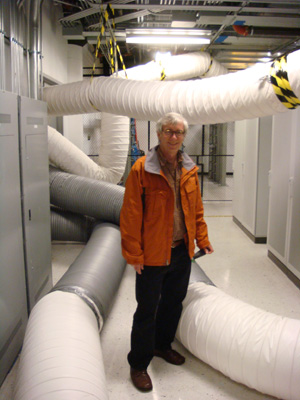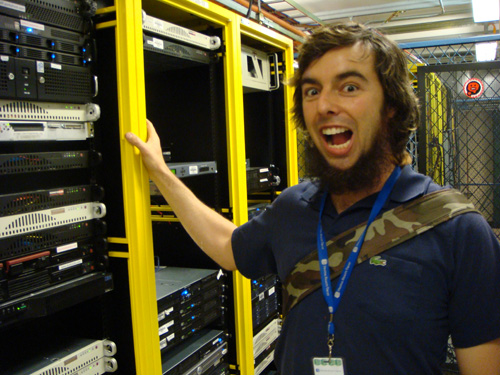
I performed my Psipunk talk at the Dorkbot SF gathering on May 2, 2007.

In the afternoon I spent some time with my favorite person in SF, the co-owner of Monkeybrains, Inc. We visited the data center where his cabinets of servers live, checking on a machine that’s sending out a 128 Meg movie of Ludacris several times a second—a.o.k. Speaking of video, there’s a funny video interview of Monkeybrain moguls Rudy, Jr., and Alex Menendez online.

Rudy Jr.’s foodhacking friend Marc Powell made ant and raspberry gum-drops for the event!
The dedicated rabble-rouser and Dorkbot impresario Karen Marcelo posted a slideshow’s worth of DorkbotSF #34 images on Flickr. We didn’t manage to tape or video it, but Rudy, Jr., pointed out that the telepathic bricks in Chicken John’s wall have the event stored in their lazy eight memories so no prob.

In Amsterdam I was uptight about my presentation because of culture shock and the language barrier, so when I was there I actually read my speech from a print-out of it I’d prepared in advance—like liberal arts types often do. I’d thought I might just read the same speech again at Dorkbot, make it a no-brainer, but—seeing all those hip, lively kids there, I didn’t want to come on all stiff and fuddy-duddy.

So I didn’t use the text or, for that matter, any computer projection—a good call, that last decision, as the Dorkbot projector was a balky device dangling from a swaying rope above the crowd of maybe two hundred, who were seated in church pews. I just stood up there and taught the lecture like a class and it went over well, lots of laughs.

I stayed till then end, then caught a train home. There were a bunch of other good presentations, one that particularly caught my attention was by a crew representing the Osaka incarnation of Dorkbot spoke, describing a vibby installation they called Openpool; they showed some Youtube videos of it. The speaker’s English was borderline incomprehensible, but, hey, how well do we speak Japanese? The images were lovely; turns out these Japanese dorks like the same kinds of things that we West coast dorks like: chaotic things. Big undulating domes of fabric. Dangling electronic mobiles twisting in the air currents.
I was listening to NOFX song “The Cause” this week to psych myself up for the talk. It perfectly expresses why I’m still out there doing things like Dorkbot and Flurb for free, not that I’m anywhere near as punk as Fat Mike. I can’t find a video of the song online, but here’s a video of their vibby song “Punk Guy,” mismatched with the lyrics for “The Cause.”

It isn’t for the money
Nor is it for the fun
It’s a plan, a scam, a diagram
It’s for the benefit of everyone
You gotta have a little respect
Subterranean ideals
Traditional of neglect
Reflect on how it would make you feel
The cause—we’re just doing it for the cause

No it isn’t for the fortune, it isn’t for the fame
It’s a scheme, a dream, a barterine[?]
We want everyone to think the same
Because you know what you know is right
And you feel what you can’t ignore
And you try so hard to point the blame
A shame—what are we doin’ this for?

The cause—we’re just doing it for the cause
The cause—we’re just doing it for the cause

Open, your eyes, don’t trust, these lies
What are we doin’ this for?
The cause—we’re just doing it for the cause
The cause—we’re just doing it for the cause.










May 2nd, 2007 at 11:45 pm
we re already..always have been. robots
May 3rd, 2007 at 1:52 pm
and after the cause the effects affects the wires threaded like silk on sheets os colors and scents only known to those who understand that the project is moving on & mutation occurz..
love from UK
May 6th, 2007 at 3:27 pm
I recorded part of your talk at Dorkbot SF.
http://vimeo.com/clip:184587
Dorkbot SF: Rudy Rucker from jay
enjoyed the talk.
May 10th, 2007 at 7:39 am
I’m with Gamma – doing it for the effects isn’t such a bad idea either.
May 17th, 2007 at 8:12 am
Hi Rudy,
“Although the notion of uploading a human into a computer is now commonplace, when I wrote Software, it was a genuinely new idea.”
I love Software, but I can’t let this claim slip by. The earliest reference to uploading that I can find is Isaac Asimov’s 1956 short story The Last Question, but there may be earlier references.
Peter.
May 17th, 2007 at 10:27 am
I’d be interested in hearing more about this, Peter. I don’t recall the uploading theme being in “The Last Question,” as I recall it was just about a supersmart machine. Can you actually post a quote from that story which has the idea of uploading human minds into the machine? Re. the newness of my ideas in 1979-1980, I had the feeling at time that no one had previously made the mind/body software/hardware analogy. So I recently thought I’d start claiming I was the first to think of uploading. As Robert Anton Wilson said, “Reality is what you can get away with.” Prove me wrong if you can!
May 17th, 2007 at 5:04 pm
“One by one Man fused with AC, each physical body losing its mental identity in a manner that was
somehow not a loss but a gain.”
May 17th, 2007 at 7:31 pm
Okay, I’ll admit that the Asimov’s story prefigures the uploading idea, but it’s thin gruel that he offers, and I don’t think he really nails it.
Actually I have a feeling there may be a much better pre-1979 instance of the idea of a person uploading their mind into a computer. Can anyone ferret it out?
I got into this line of thought in 1979 while in Heidelberg, writing the “Robots and Souls” section of my non-fiction book INFINITY AND THE MIND.
There were several things in that section I was excited about. As well as uploading, I was excited about the notoin that you had the mind’s software (data, agents, routines) and really any old hardware to put it on, then there need NOT in fact be any need to worry about the ethereal “soul”.
And, mystically inclined (and contrary) person that I am, I was NOT saying this and meaning that the world is mechanicstic and there aren’t any souls. No I was saying that the the soul (which experientialy everyone knows they have) is unitary and omnipresent. We all share the same I AM, the same glow. Even the sticks and stones among us.
I’ve always liked, in this context, the Zen Buddhist answer the the question “What is the mind?”, to wit: “The universal rain moistens all creatures.”
May 17th, 2007 at 8:17 pm
Hi Rudy,
Here are some more references to uploading in fiction:
http://en.wikipedia.org/wiki/Mind_transfer_in_fiction
“I had the feeling at time that no one had previously made the mind/body software/hardware analogy.”
John C. Lilly’s Programming and Metaprogramming in the Human Biocomputer (1968) makes this analogy:
http://www.futurehi.net/docs/Metaprogramming.html
Peter.
May 18th, 2007 at 7:46 am
Two good links from Peter Turney.
(1) An entry on Peter’s interesting blog explainging why he disbelieves the “Heroic Theory of Scientific Development.”
(2) Wikipedia, no less, lists other authors who mention uploading human minds into computers. In this entry my Software is indeed mentioned—so I’m not completely full of bull. I”m roughly contemporaneous with Pohl’s Heechee series, but I’m definiteley preceded by Roger Zelazny’s 1968 Lord of Light in which, just like in my Wetware, people save their minds as electronic data and load them into fresh tank-grown meat bodies
Another precursor is Detta är verkligheten (This is reality), 1968, by the philosopher Bertil Mårtensson, in which people become programs in a giant VR computation.
To my way of thinking, uploading into a mainframe VR is a less interesting notion of uploading than the one in which people uplaod into individual computer minds operating real bodies in the real world, as I do in Software. Although I haven’t read Zelazny’s series, it sounds as if his people don’t get new robot bodies, just new meat bodies, and their minds are, as with Mårtensson, stored in the giant global computers endemic to pre-1980s SF.
By the way in Pohl’s Heechee series, we also have a person whose mind is uploaded into a mainframe computer.
So I’m thinking maybe I can claim that Software was the first novel in which people uploaded their minds into individual robot bodies. The first desktop uploads, if you will. This was a farfetched enough notion in 1979-1980 that I actually had the robots’ computer mind housed in an ice-cream truck following the robots around. We had trouble imagining how small computers were about to get.
So, okay, I’ll tone down my I-invented-uploading claim in my Psipunk essay—but only a little.
I’ve noticed that the more successful public intellectuals are the ones who simply keep insisting that they invented ground-breaking stuff until eventually people begin believing them. My windbag role models.
Once again: “Reality is what you can get away with.”
May 18th, 2007 at 11:09 am
Turney strikes again.
He found a 1966 comic with a guy who lives in a robot body. His name is NoMan.
“NoMan was a human mind housed in an robotic body. The mind, that of Anthony Dunn, had been transferred into the robotic form as his human body passed away. NoMan had several spare bodies, and he could electronically transfer his mind from one body to the next virtually instantaneously. He often went on missions with a spare body stashed in whatever vehicle he was travelling in.”
NoMan! Or perhaps, echoing Seinfeld, I should say (clenching my fists) “Newman!”
Anyway, Professor Turney, maybe I can still say Software was the first novel with people uploading their minds into robot bodies!
May 18th, 2007 at 11:36 am
Nunquam, by Lawrence Durrell, Published: 1970
http://www.geocities.com/athens/academy/6422/rev1210.html
“Felix’s former lover, the film star Iolanthe, is dead, but Merlin decides to use her as a prototype in a project to create a mechanical being, aiming to recreate her appearance, memories and personality.”
May 18th, 2007 at 12:05 pm
Enough heckling, Peter. I frikkin’ wrote the first CS-informed cyberpunk SF novel with a human-to-robot mind upload and that’s that—or in any case I wrote the first such novel entitled Software!
Here’s a Portuguese Edgar Pera film “Who is the Master?” showing Robert Anton Wilson explaining what he means by “Reality is what you can get away with.”
May 18th, 2007 at 1:02 pm
CS Lewis said something like ‘you don’t have a soul; you ARE a soul. You have a body.’ But he believed a bunch of weird stuff. Hey, if sticks and stones become intelligent, will believers try to save their souls?
May 21st, 2007 at 9:28 am
Rudy, here are a few someehat relevant hits from Rich Erlich’s CLOCKWORKS site:
Asimov, “The Last Question.” Science Fiction Quarterly Nov. 1956. Deals with the three-stage evolution of
H. sapiens sapiens from (1) our current state, to (2) bodies with free-roaming minds, tended by
machines and, finally, to (3) minds merged with the cosmic computer; parallel development of
computers also handled. “The Last Question” is how to reverse entropy; the answer is, Creation
by the ultimate computer-god.
John T. Sladek. The Müller-Fokker Effect. London:
Hutchinson, 1970. A major character finds himself “digitalized” and trapped inside a computer. While “entombed” within the machine, he considers, among other things, the definition of the noun “man.”
A.C. Clarke, 2001: A Space Odyssey (but not the film) has ET minds stored in spaceships (1968).
Fritz Lang‘s film METROPOLIS shows “essence” (my term) of Maria used to animate Robot Maria in
some sort of soul transfer (except human Maria is unchanged).
Cf. and contrast M. Coney’s Celestial Steam Locomotive, B. Daley’s Tron, F. Saberhagen and R. Zelazny’s Coils, J. Varley’s “Overdrawn at the Memory Bank”.
What it looks like to me is that you wrote the first novel/story of this type that actually referenced real-world
hardware/software in a nuts-and-bolts way instead of saying ‘. . . and then they put their minds in a computer.’
I’d exclude Noman, who had no backup storage if all his bodies died, and LORD OF LIGHT, in which minds are hot-swapped into new blank bodies but not stored. And Pohl’s second Heechee book was 1980, which is more like a tie.
Boris and Arkady Strugatsky had a botched attempt at an upload in a 1961 book, but not much Russian SF made it over here.
When you used it in Software, uploading was a mint-new, relatively unscratched idea.